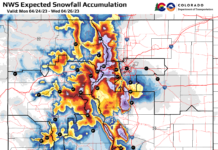The Colorado Department of Public Health and Environment this week released its final 401 water quality certification for the proposed Windy Gap Firming Project (WGFP), which would divert additional water from the Upper Colorado River to northern Front Range communities. Trout Unlimited praised the 401 permit conditions for reaffirming the health of the Upper Colorado River and its world-class trout fishery.
“We firmly believe these permit conditions establish a strong health insurance policy for the Upper Colorado River,” said Mely Whiting, counsel for Trout Unlimited.
For years, Front Range water diversions have removed about 60 percent of the native flows of the Colorado headwaters, severely impacting fish and other aquatic life that depend on healthy flows to clean cobble and prevent the buildup of habitatchoking algae and sediment. The proposed Windy Gap expansion would further reduce native flows.
Trout Unlimited said the conditions included in the 401 permit for WGFP address critical fish habitat and water quality needs by:
•preventing stream temperature impacts during low flows in the summer.
•providing periodic “flushing flows” to cleanse the river during runoff.
•requiring ongoing monitoring and response if degraded conditions are detected.
The 401 permit conditions largely incorporate the protections included in earlier agreements involving the WGFP sponsor, the Municipal Subdistrict of the Northern Colorado Water Conservancy District (Subdistrict) and its project participants, and other stakeholders, including Grand County, Trout Unlimited, and the Upper Colorado River Alliance.
Under the 401 permit, the Subdistrict is required to monitor specifically for stream temperature, key nutrients, and aquatic life and submit results with an annual report that identifies any evidence of impairment (standards not met). If impairment is identified, the Subdistrict has to investigate to determine whether WGFP is causing or contributing to the impairment. If WGFP is found to play a role, then the Subdistrict is required to come up with a plan to solve the problem, consistent with state water quality laws.
“This long-term monitoring and flexibility of response is called ‘adaptive management’—and it’s a critical feature of the permit requirements,” said Whiting.
“Adaptive management recognizes that stakeholders can’t foresee every problem, and it provides a process for ongoing monitoring and mitigation of river problems as they arise.”
Trout Unlimited noted that the permit builds on years of hard work, negotiations and collaboration. “We wouldn’t be at this point without the leadership of Grand County and their persistent efforts to improve the health of the Colorado River,” said Kirk Klancke, president of Trout Unlimited’s Colorado River Headwaters chapter. “And the Northern subdistrict also deserves credit for listening to our concerns and working with all stakeholders to find solutions.”
“This permit is another step toward fulfilling the Windy Gap Firming Project’s potential to be part of a balanced water supply strategy for Colorado’s Front Range,” said Drew Peternell, director of TU’s Colorado Water and Habitat Project. “Through a balanced portfolio—including responsible supply projects like WGFP, along with stronger conservation and reuse programs and ag-urban water-sharing— Colorado can meet its diverse water needs, from municipal needs to recreation, while keeping our rivers healthy.”
Under Section 401 of the federal Clean Water Act, the state of Colorado must provide the U.S. Army Corps of Engineers with a permit certifying that the project will comply with federal water quality standards. The remaining regulatory hurdle for the Windy Gap Firming Project is the final 404 wetlands permit by the Army Corps of Engineers, which the Corps could issue in 2016.
Issuance of all permits for the project will release resources, including money needed for the design and construction of the Windy Gap Reservoir Bypass to create a new river channel and reconnect the river and its fisheries upstream and downstream of the reservoir.
“It’s been a long and arduous process,” said Whiting of the WGFP permitting process, which has taken over 10 years. “It is time to roll up our sleeves and go to work for the river.”
Trout Unlimited is the nation’s largest coldwater conservation organization, with 147,000 members dedicated to conserving, protecting, and restoring North America’s trout and salmon fisheries and their watersheds. Colorado Trout Unlimited has more than 10,000 grassroots members across the state.







